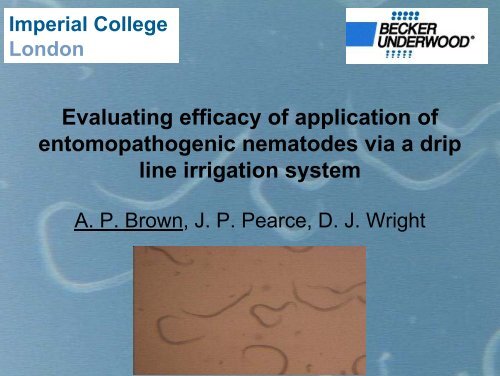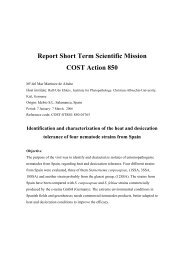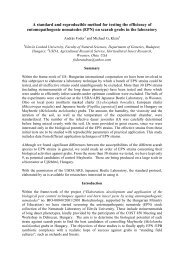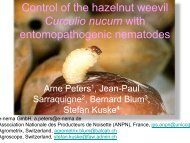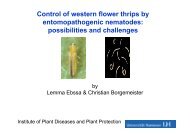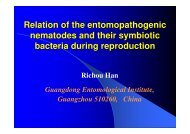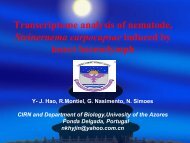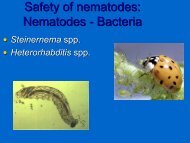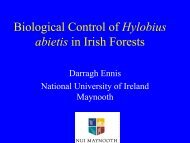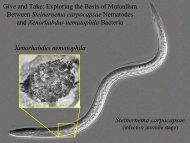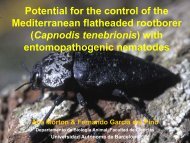Download PDF, 807 KB - COST Action 850
Download PDF, 807 KB - COST Action 850
Download PDF, 807 KB - COST Action 850
You also want an ePaper? Increase the reach of your titles
YUMPU automatically turns print PDFs into web optimized ePapers that Google loves.
Imperial CollegeLondonEvaluating efficacy of application ofentomopathogenic nematodes via a dripline irrigation systemA. P. Brown, J. P. Pearce, D. J. Wright
Outline• A guide to the use of drip irrigation in UK agriculture.• The possibility of integrating EPN application into alreadyexisting irrigation systems and the problems with thisapproach.• Suggestions on how these many be able to beovercome.• Future possibilities for application of EPN.
Drip irrigation in UK agriculture
Drip irrigation in UK agriculture• Drip irrigation used in many high value crops highlydependent on water.• Within the UK the two main irrigation companies areNetafim (Israel) and T-Systems International (USA), withapprox. 5 other smaller companies.• Netafim has largest market share (7x nearest rival).• There are a lot of choices for growers, EPN applicationsuitability has never been considered. Guidelines areneeded.
• Variations in cost are one of main factors but this ischanging.Variety of drip irrigation lines available• Grower can choose from:– Supplier– Model of irrigation line (Netafim = 12)– Flow rate (3 or 4 rates)– Emitter spacing (up to 11 spacing)
Why apply via drip-line irrigation?• Very few EPN specific application devices have beendeveloped for this niche market.• Many high-value crops, onto which nematodes areapplied, have irrigation systems already in place.• Integration into existing irrigation systems widens themarket potential of these products.• With >80% of invertebrate pests having at least part oftheir lifecycle in the soil, application via irrigation systemswould enable EPN to be placed close to their target.
Methods• A 100 m irrigation rig hasbeen constructed to allowaccurate sampling ofwater and EPN emissionfrom set points along theirrigation tape.• Irrigation line lengths of100, 79, 50, 25 and 18 mwere investigated.• Irrigation tape used:Netafim RAM17012.
Methods: The irrigation system
Preliminary studies identified problemGeneral trend in total EPN released along an irrigation tape.300250EPN concentration (EPN/ml)200150100“Dead zone”5000 10 20 30 40 50 60 70 80 90 100Percentage distance (%)
Settling of EPN can occur in two places:1. The irrigation tape (caused by stagnation of water)Effect of irrigation tape internal flow rate on EPN distribution.500450400Control1 bar2 barEPN concentration (EPN/ml)3503002502001501005000 2 4 6 8 10 12 14 16 18Distance (m)
2. Within the tank mix prior to irrigationThe effect of adding carboxymethlycellulose (CMC) to tank mix.800EPN concentration (EPN/ml)700600500400300200100Control0.1% CMC00 10 20 30 40 50 60 70 80Time (mins)
Modelling EPN output from an irrigation lineAim: Investigate “Dead zone” region of irrigation line.• 100 l water/EPN mix.• Different length irrigation line used (100, 79, 50, 25 and18m).• Sampling points positioned at percentages of the line aswell as set differences from the end.• Reynolds number calculated at point where EPN outputis reduced.
The effect of total irrigation line length on EPN releasedistribution.500Effect of distance to run on EPNtput2. Effect of percentage distance onEPN output500450450400400350300250200150100100.0179.4350EPN concentration (EPN/ml)350300250200150100100.0178.53505018.115018.11010025.388060Distance to run (m)40200025.30 20 40 60 80Percentage distance (%)
ResultsPercentage to run model:r 2 = 0.544 (df, 102) p = 4.74 x 10 -16HOWEVER……Set distance to run model:r 2 = 0.545 (df, 103) p = 2.2 x 10 -16Percentage distance to run model against set distance to run model:p = 0.7419Conclude: Size of “Dead zone” increases with increased total length ofirrigation line but it is not a proportional increase.
Reynolds number• Unit less number to measure turbulence.• 4000 turbulent flow.• By modelling output and relating it to the Re futureirrigation lines can have their suitability ascertainedwithout experimental work.• Calculation takes into account flow rate and diameter.
Effect of distance on Reynolds number12000.00160.00150.0010000.00140.00130.00120.00Re8000.006000.004000.00110.00100.0090.0080.0070.0060.0050.0040.00Percentage1st emitter (%)2000.0030.0020.000.00ReEPN0.8 25.1 50.3 70.4 74.9 76.7 84.8 88.4 91.1 95.6 97.4 99.8Distance (m)10.000.00
Effect of nematode speciesThe effect of nematode species on output distribution.12000010000080000Total EPN output6000040000200000S. feltiaeS. carpocapsaeS. krausseiP. hermaphrodita0 10 20 30 40 50 60 70 80 90 100Distance (m)
Effect of species size on settling rate9.08.07.0IJ settling rate (mm/min-1)6.05.04.03.02.01.00.00.000 0.001 0.002 0.003 0.004 0.005 0.006IJ approx. volume (mm3)
Field observations• Field recordings of nematodeoutput were taken along an81 m irrigation line applyingNemaslug® to a lettuceplantation.• Irrigation tape used – NetafimStreamline.• Nemaslug® applied at a rateof 125 million/ha.• Water applied at 0.5 bar at arate of 10,000 l/ha.
Nematode distribution from field observations.MPN concentration (MPN/ml)<strong>807</strong>06050403020100Line 3Line 15Line 28Line 33Line 35Line 39Line 42Line 43Line 54Line 580 20 40 60 80 100Percentage distance along line
Conclusions‣ With increased tape length the “Dead zone” atend of tape increases but not proportionally tothe total length.‣ There is an exponential decrease in EPN outputwith increased time.‣ Nematode species does not affect output distributionfor the tape types tested so far.‣ For Netafim RAM 17012 EPN output is similar whenbeing used within the irrigation manufactures pressurerecommendations.‣ The key factor affecting EPN distribution is most likelyirrigation tape type (but more work is needed).
The future of work like this….In-line drip irrigationOverhead irrigation
Acknowledgements• Dr. Roy Bateman and Dr. Simon Leather.• Dr Simon Piggott and Cyrille Verdun, BeckerUnderwood,Littlehampton, UK.• Dr Ben Raymond and Brian Pickett, Department of BiologicalSciences, Imperial College, London, UK.• Julian Gruzelier, Revaho UK Ltd, Skelmersdale, UK.• Funding for this work was provided by BBSRC andBeckerUnderwood.www.iparc.org.ukEmail: Andrew.Brown@imperial.ac.uk


